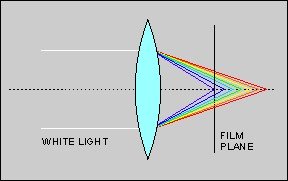|
Chromatic AberrationChromatic aberration is caused by different wavelengths of different color lights, passing through a lens. As we know, when white light is passed through a prism, it breaks in a spectrum of colors. This is because of each color light has different wavelength, and therefore they have different refractive index. As a section of lens, through which the light is passed, is practically a prism in shape, the white light breaks into its components.
So in this case, when blue color is sharply focused, red will be slightly out of focus and when red is sharply focused, blue will be slightly out of focus. The result in an image is a red or blue fringe of color on the light and dark boundaries and some loss of definition.
Fluorite is a material with lower dispersion index, however, the material is not stable for its shape and changes its shape with temperature variations. Also, atmosphere acts on it and it is damaged by seasoning. A well designed lens uses these technology and chemistry to minimize chromatic aberration of the lens. And that is the reason why lenses for professional use are so expensive. Digital post processing and photo editing software can correct this fault up to some extent, but some loss is always there. Read about these lens faults in detail: Blur or defocus of lens: Blurring of an image due to lens fault
Diffraction: Scattering of light causing diffraction in an image Field curvature: Field curvature aberration of a lens
Lens flare: How to take care of a lens flare Loss of contrast: How ability of capturing contrast of a lens is lost
Optical distortion: Physics of optical distortion and how to check it Spherical aberration: Optics of spherical and asherical lens
Return back to camera lens from chromatic aberration
|





 In camera image focusing, this physics plays its negative role and image focusing for each color light is at different distance, from the lens to the film plane or image sensor.
In camera image focusing, this physics plays its negative role and image focusing for each color light is at different distance, from the lens to the film plane or image sensor. 
